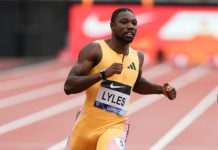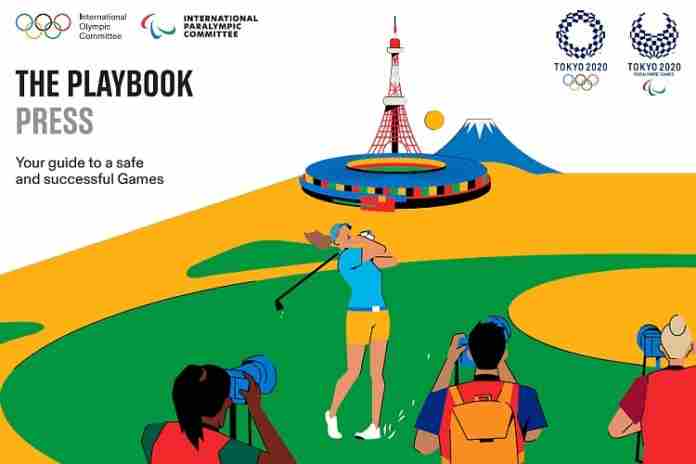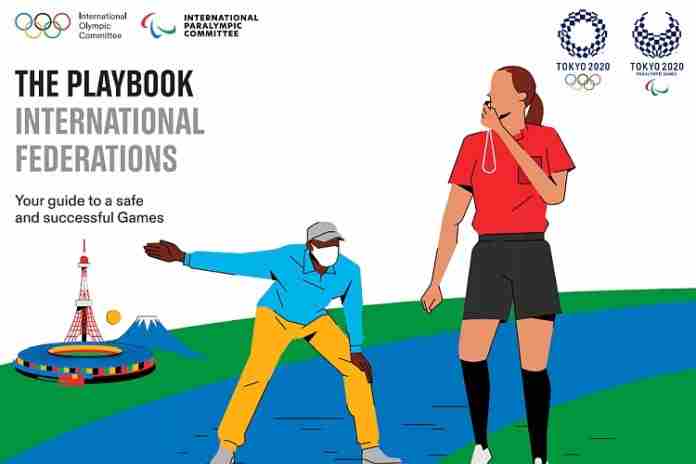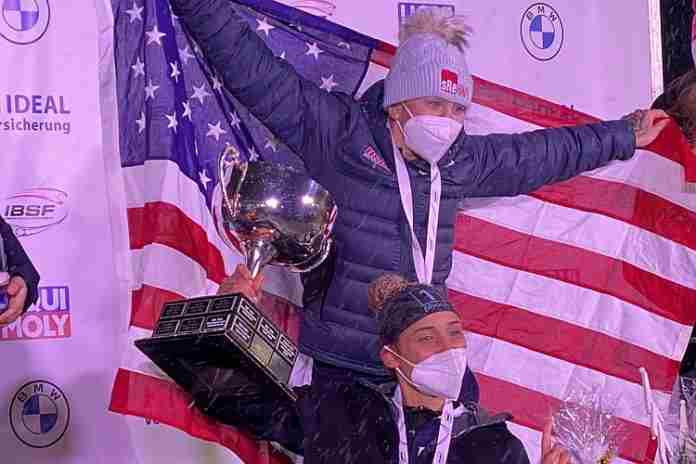(★ Friends: So many thanks to our 42 donors toward our December bill for server and support costs; we’re now at 97% of our goal. If you would like to help, please donate here. Your enthusiasm is what keeps this site going. ★)
On Thursday, the International Olympic Committee published two more editions of its “Playbooks” for stakeholders in the Tokyo Olympic Games this summer, for rights-holding broadcasters and for all other news media, under the banner of “Press.”
While a lot of the information on travel, testing and contact tracing is the same as that published in the International Federations Playbook, the critical regulations for both groups is contact at the Games with athletes, and with each other in facilities like the International Broadcast Center and the Main Press Center. The main principles remain the same: “it is important to minimise social interaction, wear a mask, and avoid the 3Cs: spaces that are closed, crowded or involve close contact.”
For the broadcasters, their primary work positions in the venues are the commentary boxes for their announcers and the post-competition mixed zones for interviews. The regulations make sense, at least in the abstract:
“All [rights-holding broadcasters] will be permitted to conduct interviews and film with athletes at the Venue Mixed Zones and at the Olympic/Paralympic Village Plaza Mixed Zone. Where dedicated transport is available, interviews may also take place at the [International Broadcast Center] and RHB TV studios. These locations must have temperature checks conducted on entry including the Olympic Village Plaza Mixed Zone and be able to guarantee physical distancing of athletes along with the highest standards of sanitation and personal protection equipment [to be defined further later].
“Please note that capacities in venue broadcast facilities will be adjusted in order to comply with the adopted physical distancing measures. These facilities include Mixed Zones, Dedicated Camera Platforms, Announce Positions/Occasional Presentation Positions (OPPs), Commentary Positions, Observer Seats and Broadcast Compounds, as well as at the Olympic/Paralympic Village Plaza Mixed Zone and the TV Studios.
“All ENG Mixed Zone positions, ENG platforms and Observer Seats will require booking through [Olympic Broadcast Services].”
But the details make it clear that the broadcast situation in Tokyo will look far different than ever before:
● Commentary positions and observer seats:
“At least a one-metre distance will be maintained without enlarging the overall footprint:
– “In order to maintain a one-metre distance, two people will be allowed in each three-seater position (EP03/UP03). One person to be allowed in each two-seater position (EP02/UP02) and one person in a one-seater position (EP01)
– “Clear acrylic partition to be installed where physical distancing is not possible
– “Observer Seats to follow physical distancing measures for Spectator Seats.” (Emphasis added)
● Mixed zones:
– “At all venues, a maximum crew of two people will be allowed at all dedicated TV positions (MZ01). In Radio positions (MZ02), only one person will be allowed
– “The use of a boom microphone will be mandatory in order to ensure the two-metre distance between athletes and interviewers is maintained
– “The floor of the Mixed Zone will be marked at all venues to ensure physical distancing: Athlete position < two metres > RHB position
– “The number of people accessing the Broadcast side of the Mixed Zone will be strictly controlled”
Mixed zones are always crowded, but are going to be much less so in Tokyo. The result is that the production effort will be even more chaotic that normal as broadcasters try to do their work while trying not to get in the way of other networks, and athletes and officials just trying to get by.
● International Broadcast Center:
– “RHBs will have to ensure at least one-metre distancing from others within their private
broadcast areas and the IBC, and two-metre distancing from athletes
– “If unable to keep the one-metre distance in certain operational areas, clear acrylic partitions should be installed by the Broadcaster …
“Athletes will have to be able to be transported from the Olympic/Paralympic Village to the
dedicated drop off points by dedicated RHB and NOC/NPC vehicles.”
These are not insignificant restrictions when one considers that in Rio for 2016, the Rights-Holding Broadcasters claimed 12,912 accreditations (!), with another 6,887 personnel from the host broadcaster team. Some 16,771 of these folks (85%) were assigned to work in the competition venues.
The restrictions for the press are even more difficult. In Rio, the “press” contingent (accreditation category “E”) was made up of 5,897 individuals from various groups, including:
● 3,651 writers
● 1,472 photographers
● 443 non-rights-holding broadcasters
● 331 technicians and support staff
All of them will have to face this situation:
“All press and photo areas across the competition and non-competition venues of Tokyo 2020 Games have been redesigned in order to ensure the required measures for physical distancing are respected at all times by the E-accredited Press. This has been done to guarantee a safe environment for all reporters, photographers and their support staff covering the Games. Similarly, access to the Olympic/Paralympic Village Plaza Mixed Zone will be limited. …
“Requirements for physical distancing at the MPC, venue media centres, press tribunes, press conference rooms, mixed zones, photo positions and media lounges has resulted in a significant reduction of capacities for all press and photo areas, with an average loss of 50 per cent in capacity for both. (Emphasis added)
“As a result, a booking system [to be later defined] for daily access to competition venues will be in place throughout the Games that will require every member of the accredited press to make a daily request in advance. Requests will be approved in accordance with the venue capacity for the different press and photo areas. (Emphasis in original)
“Approval of requests will be based on similar principles applied for the high demand events:
– “to guarantee international coverage of the events;
– “to ensure access to accredited press representing the NOCs/NPCs whose athletes and teams are competing in the events; and
– “to ensure an efficient and safe working environment for all media …
“While the priority is always to facilitate and support the accredited press in their work in covering the Games, the movements of reporters and photographers within the venues and their access to press and photo areas will be subject to physical distancing requirements. Additional measures and processes for access to press tribunes, mixed zones, photo positions and press conference rooms might have to be followed once in the venues.
“All press conferences will be available online and dedicated platforms will be used to allow for live Q&A for the Olympic Games …
“If dedicated transport is available for the athletes, interviews may also take place at the IBC/MPC and the Olympic/Paralympic Village Plaza Mixed Zone. These locations must have temperature checks conducted on entry and be able to guarantee physical distancing of athletes along with the highest standards of sanitation and personal protection equipment.”
The statement of “an average loss of 50 per cent in capacity” for “all press and photo areas” is no idle estimate. The reality is that the field-of-play and mixed-zone footprints cannot be expanded much from the pre-Covid space allocation – since the venues have remained the same – and that the first priority for space, especially in the mixed zones, will go to the rights-holding broadcasters.
Which raises the question of just how much can a reporter or photographer actually get done in Tokyo? So, can reporters – at least – stay home and cover the Games remotely, with access to ask questions via the Games information system?
The answer appears to be no, according to the IOC’s Head of Media Operations, the highly-experienced Lucia Montanarella (ITA). From a summary story of a 26 January video conference hosted by the International Sports Journalists Association (AIPS):
● “We redesigned the venues and all the Press areas had been adjusted for the requirements of physical distancing: 2 meters from athletes and 1 meter from the rest of the stakeholders. By applying these restrictions, we obviously lost an enormous capacity of Media positions, especially for photographers.”
● “For the first time ever, video coverage press conferences with the medallists will be available for use by the accredited media once the live events finish. There’s going to be a feed on the info system to provide as much content as possible.”
● Montanarella explained that there is not going to be virtual accreditation to cover the Games remotely: “We are going to prioritise those that are making the effort of travelling, with all the difficulties and investment that this brings, in a way to offer them more opportunities, as we need to have a proper balance.”
To go or not to go? Even space in the Main Press Center workroom is not assured; while access will not be restricted:
“The MPC working areas will be reduced to allow for physical distancing and will be available on a first come first serve basis.”
This is the impact of Covid on a group that the IOC deeply wants at the Games to chronicle the triumph of having the event at all.
One group which will be deeply impacted by this will be the press officers from the National Olympic Committees. The big NOCs will have significant teams working at the event to help with athlete access; the U.S. Olympic & Paralympic Committee media support team has been in the dozens for decades, but smaller NOCs might have one media officer to support its entire delegation. Never will these people be more challenged, or more needed by their country’s news media; look for some clever, innovative arrangements to deal with this from the more experienced teams.
Media which have been selected by their NOCs for accreditation are being requested to re-confirm their attendance later this month, and given the costs involved and the new restrictions, the decisions will not be easy.
Further details will be forthcoming in an April revision and expansion of these Playbooks, but for now, it’s worth sending good wishes for success (and patience and understanding) to Montanarella and Tokyo 2020 press operations head Ryo Nishimura.
As the Press Operations chief for the 1984 Olympic Games in Los Angeles, let me say – as the Paris 2024 organizers would put it – Bonne Chance! All the best!
Rich Perelman
Editor
You can receive our exclusive TSX Report by e-mail by clicking here. You can also refer a friend by clicking here, and can donate here to keep this site going.
For our 709-event International Sports Calendar for 2021 and beyond, by date and by sport, click here!




























